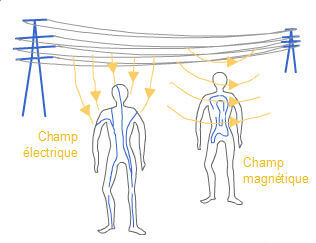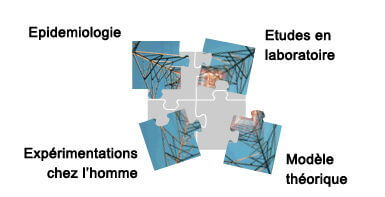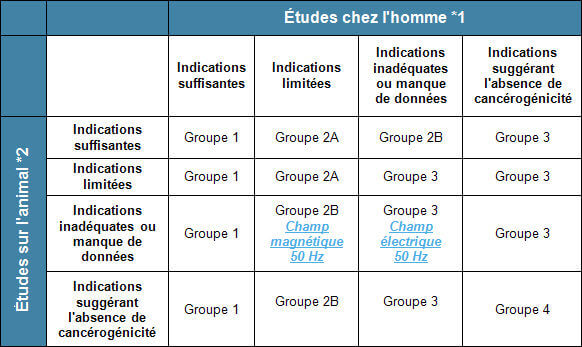From television to the freezer and even the spark needed to trigger the fuel heater, electricity gives us a cosy life. Here we will see risks associated with our “Electricity fairy”, especially the potential effects on health of exposure to 50 Hz electric and magnetic fields. This page intends to present how potential health risks are studied and taken into account in guidelines and recommendations. In Exposure analysis, we will explore the meaning of the epidemiological threshold (0.4 µT).
Health risk issues: Standards, research and exposure analysis
Fields emitted by mobile phones or their base station will not be examined here (for information on these fields, see an Introduction on Health & Radiofrequencies).
Established and potential effects
Established effects
In case of exposure to very high intensities of 50 Hz magnetic and/or electric fields, acute direct effects can occur. These effects are well studied in human volunteers and animals. Recommendations and standards are intended to protect us from these short term established effects.
Short term effects depend on the local intensity of the electric field in each tissue. This explains why the reference unit is the internal electric field expressed in Volt per meter (V/m).

50 Hz electric fields only partly penetrates the human body (it is roughly reduced by a one million factor between the outside and the inside of the body). It rather causes the oscillation of electric charges (ions) on the surface of the body. This generates currents that circulate on the body surface towards the ground and a residual current inside the body.
50 Hz magnetic fields do penetrate the human body and induce electromotive forces that generate currents called “Eddy currents”. These currents form closed loops perpendicular to the direction of the magnetic field.
There are a number of well-established acute effects of exposure to low-frequency electric and magnetic fields on the nervous system:
- Direct stimulation of nerves and muscle tissue
- Induction of retinal phosphenes (*).
(*) Phosphenes are flashes of light that can be perceived in the eye. These flashes can be directly induced by mechanical, electrical, or magnetic stimulation of the retina. High magnetic fields can induced current at the retina level, that could lead to magnetophosphenes.
There is also indirect scientific evidence that brain functions such as visual processing and motor co-ordination can be transiently affected by induced electric fields.
All these effects have thresholds below which they do not occur and can be avoided by meeting appropriate basic restrictions on electric fields induced in the body.
Exposure to low-frequency electric fields causes well-defined biological responses through surface electric-charge effects. Prevention of the painful effects of surface electric charge induced on the body by such exposure are addressed by the reference levels in the standards.
One should also know that electric currents do naturally occur in the human body:
- An electroencephalogram is the trace of electric activity of the brain. Electricity produced by brain neurones is recorded with electrodes placed on the scalp.
- An electrocardiogram is the trace of electric activity of the heart. The heart is a muscle which, just like every muscle, emits a certain amount of electricity when it is working. The electricity emitted can be recorded with the help of electrodes.
Potential effects
Numerous questions are now arising involving health effects of exposure to 50 Hz electric and magnetic fields, especially long term exposure with low levels of intensities often met in our everyday life.

| Public concerns | Fields of research |
| cancer? – headaches? – sleep disturbance? – general health? – Alzheimer’s disease? – amyotrophic lateral sclerosis? – lipoatrophia semicircularis? | cancer – cell action mechanism – effects on reproduction – effects on general health – sleep disturbance – hypersensitivity – neurodegenerative diseases – neurobehavior – lipoatrophia semicircularis |
In the absence of clear scientific evidence that these effects are causally related to 50 Hz EMF exposure, these concerns are classified as potential effects.
Standards and recommendations
The main objective of Standards, recommendations and guidelines is to provide protection against all established adverse health effects of electric and magnetic fields (EMF). Here are the limit values of ICNIRP and Europe.
ICNIRP guidelines
The reference levels for exposure to 50 Hz electric and magnetic fields are:
- for the public (everyday exposure): 5 kV/m – 160 A/m – 200 µT
- for workers (occupational exposure): 10 kV/m – 800 A/m – 1000 µT
See further in Standard pages: for the public / for workers.
European recommendations and guidelines
In 50 Hz, here are the reference levels (public) and action levels (workers):
- for the public (everyday exposure): 5 kV/m – 100 µT
- for workers (occupational exposure):
- Electric fields: Low ALs 10 kV/m, High ALs 20 kV/m
- Magnetic fields: Low ALs 1000 µT, High ALs 6000 µT and ALs 18 mT for exposure of limbs to a localised magnetic field
See further in Standard pages: for the public / for workers.
National interpretation of recommendations
Each country is free in the interpretation of recommendations and establishment of its own standards.
Belgium has standards for the exposure of the general public to electric fields:
- 5 kV/m in inhabited areas, or areas intended for habitation on sector map
- 7 kV/m with overhangs of roads
- 10 kV/m in other places
There is no national legislation limiting 50 magnetic field exposure. Note that the maximal level of magnetic field encountered under a high voltage powerline (measured with respect to legal security distance) is always below 50 µT (See further in FAQ on Powerlines & Cables).
However, to be complete: a Flemish Governmental arrest provides quality values for various indoor chemical and physical agents. For magnetic fields, it proposes a guide value of 0.4µT and an action value of 20µT, without other specifications.
In the Brussels-Capital region, there is a decree on operating conditions of static transformers (nominal power between 250 and 1000 kVA) (9 September 1999):
- The value of the undisturbed electric field, in undisturbed regime: < 5 kV/m
- Outside the substation, the value of 50/60 Hz magnetic induction is limited to 100 µT (permanent exposure) and 1000 µT (acute exposure).
- The following requirement also applies to all new static transformers: 0.4 µT as a guide value and an action value of 10 µT.
See further in Standard pages (in Belgium).
Methods of research
Four main methods of research
They are several methods to study potential effects of 50 Hz electric and magnetic fields on health.

1. Epidemiology
In epidemiology, studies focus on research for the existence of a statistical association between a given factor and the appearance of a disease. Two main types of epidemiological studies are usually carried out: analytical (ecological, case-control, exposed-unexposed) and experimental (trials) epidemiology:
- Ecological studies focus on the comparison of groups, rather than individuals: they study the association (correlation) between exposure variables and health, when researchers do not have any individual data.
For example, this kind of survey can be used to study the relationship between the concentrations of air pollutants (CO2, ozone,…) and mortality collected in the following days from hospital data and death certificates. - Case-Control

- Exposed-Unexposed

- Trials: means that researchers control the exposure conditions of the subjects. Groups exposed and unexposed are monitored and compared with respect to the impact of the event studied.
2. Laboratory studies
Research for mechanisms of action of electric and magnetic fields:
- on cells or in vitro: studies are carried out in a laboratory using cells or tissues. The term “in vitro” refers to the observation of phenomena “under glass” (i.e. in test tubes or dishes of the laboratory)
- on animals or in vivo: studies are based on the observation of phenomena occurring in living organisms. Example: studies carried out on animals in a laboratory: rats, rodents …
3. Experimental studies on humans
Volunteers are subjected to 50 Hz electric and magnetic fields for short period of time, under controlled exposures. Multiple functions are analysed : Memory, attention, reaction time, electrical activity of the brain, immunological parameters (white blood cells …) …
4. Theoretical modelling
Reconstitution of electrical properties of the human body on computers. From models, computers calculate with precision the distribution of currents induced by an external field and other electrical parameters.
Pros and cons of the various methods
Each method presents advantages and disadvantages and allows to take into account one aspect of the problematic:
Case-Control and retrospective Exposed-Unexposed studies
- Advantages: inexpensive and feasible within a short time
- Disadvantages: the difficulty of rebuilding case and control histories in a comparable way and without bias
Prospective Exposed-Unexposed studies
- Advantages: better bias control
- Disadvantages: high cost and difficulty of carrying out this type of study whenever the disease is rare or occurs after a long latency period.
In vitro studies
- Advantages: investigation of mechanisms of action at cellular level
- Disadvantages: cells or tissues are removed from their natural environment, thereby eliminating interaction and protection mechanisms otherwise available from the donor organism
In vivo studies
- Advantages: Studying the effects on a living organism
- Disadvantages: experimental conditions often vary from real conditions. Moreover, it is difficult to extrapolate the results of animal studies to the case of actual human exposure.
Experimental studies on humans
For obvious ethical reasons, volunteers are never exposed in laboratories to high intensity magnetic fields for a long time. This type of study is not indicated for research on cancer, reproduction or other diseases that occur after a latency period or a long exposure
Theoretical modelling
At this time theoretical modelling is still in development. In the field of biomedical research, modelling intends to compute electromagnetic fields inside living organisms.
Note: For the interpretation of results related to low risk factors in complex domains, one single study (or type of study) cannot give a definitive answer: results must be confirmed on diverse modalities.
Main research results
At this time, for the effects studied, findings of research are sometimes positive, sometimes negative. There is no straight answer. In the absence of sufficient evidence, scientists are unable to confirm or invalidate the presence of effects of 50 Hz electric and magnetic fields on health.
For cancer, one finding emerges from epidemiologic studies. It consists of a doubling of leukaemia risk among children daily exposed to average magnetic fields in excess of 0.4 µT.
It means that a statistically significant relationship exists between exposure to magnetic fields and childhood leukaemia. A statistically significant difference does not prove a causal relationship.
For neurodegenerative diseases, some previous epidemiological studies indicated some link between ELF-MF and Alzheimer disease, but it is not confirmed by the newest research works. However, considering uncertainties, research is ongoing.
Establishing a relationship of cause and effect requires the checking of several criteria (Hill criteria):
- consistency of association and reproducibility whatever the population
- relationship between the dose (exposure level) and the effect
- coherence with results of the studies already published in scientific literature
- plausibility of the biological mechanism highlighted, …
Before concluding that magnetic fields are harmful, results derived from epidemiology have to be confirmed, essentially by laboratory studies.
We have to keep these results in mind when analysing our exposure to 50 Hz EM fields.
Exposure analysis
Carcinogenicity of magnetic fields
The International Agency for Research on Cancer (IARC) classified agents, mixtures or exposures in 4 groups as to their carcinogenic risk to humans (November 2017).
| Agent (mixture or exposure)… | Examples | |
|---|---|---|
| Group 1 | … is carcinogenic to humans | Alcoholic beverages – Asbestos – Benzene – Engine exhaust, diesel – Radon – X- and Gamma-Radiation – Solar radiation – Ultraviolet-emitting tanning devices – Tobacco – Formaldehyde – Consumption of processed meat… 120 agents in total. |
| Group 2A | … is probably carcinogenic to humans | PCBs – Acrylamide – Very hot beverages at above 65 °C (drinking) – Consumption of red meat … 81 agents in total |
| Group 2B | … is possibly carcinogenic to humans | Engine exhaust, gasoline – Chloroform – Gasoline – Pickled vegetables … 299 agents in total |
| Group 3 | … is not classifiable as to carcinogenicity in humans | Coffee (drinking) – Caffeine – Coal dust – Fluorescent lighting – Diesel fuels – Mercury – Saccharin – Tea … 502 agents in total |
| Group 4 | … is probably not carcinogenic to humans | One agent in group 4: Caprolactam |
In IARC classification, the agents, mixtures or exposures are classified as to their carcinogenic risk to humans in accordance with the results of studies in humans and animals. Mechanistic and other relevant data are also taken into account.

Source: IARC website
See Classification of IARC for information on categories in humans and animals
There is limited evidence in humans for the carcinogenicity of 50 Hz magnetic fields in relation to childhood leukaemia (from epidemiological studies) and inadequate evidence in experimental animals for the carcinogenicity of 50 Hz magnetic fields. This is why IARC classified them in group 2B, as possibly carcinogenic to humans.
IARC has decided that 50 Hz electric fields could not be classified as to their carcinogenicity to humans and have joined group 3.
The World Health Organization (WHO) put forward their position concerning this classification:
“While the classification of ELF magnetic fields as possibly carcinogenic to humans has been made by IARC, it remains possible that there are other explanations for the observed association between exposure to ELF magnetic fields and chlidhood leukaemia.”
Exposure to 0.4 microT ?
Researchers estimate that less than 1% of the population is exposed to levels on an average equal or higher than 0.4 µT.
Researchers from VITO (Vlaamse Instelling voor Technologisch Onderzoek) in Flanders have established an analytical model based on parameters of high voltage powerlines and have calculated a line corridor where fields levels are on average equal or higher than 0.4 µT.
The table below presents the distance in meter from the axis of the line (or the half width of the corridor) according to the load of the line (in %):
| Line voltages | Load of the line in % and 1/2 width of the corridor “0.4 µT” |
|---|---|
| 70 kV | 25% – 9 m 50% – 18 m 75% – 27 m 100% – 36 m (on average 15m) |
| 150 kV | 25% – 15 m 50% – 30 m 75% – 43 m 100% – 58 m (on average 40m) |
| 380 kV | 25% – 33 m 50% – 66 m 75% – 98 m 100% – 130 m (on average 90m) |
Source : Mira report, 2011
Here are data on underground cables in Flanders:
| Cable voltages | Load of the line in % and 1/2 width of the corridor “0.4 µT” |
|---|---|
| 36 kV | 25% – 0.65 m 50% – 1.25 m 75% – 1.9 m 100% – 2.55 m |
| 70 kV | 25% – 0.9 m 50% – 1.8 m 75% – 2.7 m 100% – 3.6 m |
| 150 kV | 25% – 1.3 m 50% – 2.55 m 75% – 3.85 m 100% – 5.1 m |
Source : Mira report, 2011
Researchers from VITO have also counted the children between 0 and 15-year-old who live in districts where the mean value of 0.4 µT could be obtained :
- If the load is 25%, 0.35% of children living in the vicinity of 150 kV powerlines are exposed to 0.4 µT on average
- If the load is 50%, 0.7% of children living in the vicinity of 150 kV powerlines are exposed to 0.4 µT on average
- If the load is 75%, 1% of children living in the vicinity of 150 kV powerlines are exposed to 0.4 µT on average
- In the case of a maximal load, 1.4% of children living in the vicinity of 150 kV powerlines are exposed to 0.4 µT on average
While the load of the line is maximal, 1.4% of children living in districts in the vicinity of 150 kV powerlines are exposed to 0.4 µT on average (in Flanders).
It is worth noting that high voltage powerlines are not our only source of magnetic field exposure. To take into account general exposure, a campaign of 50 Hz magnetic field exposure measurement is being performed in children from 0 to 15-year-old by researchers from VITO .
Children carry all day long a recorder (a gaussmeter: a magnetic field measurement device) that continuously measures their actual exposure, at home, at school, during transport, during their sleep … Data were collected for 651 children:
- 91.9% of children having participated in the measurement campaign are exposed to less than 0.1 microT
- There are 1.1% exposed to intensities higher than 0.4 µT
Revising standards and guidelines?
In the light of the results, is there a need to review and lower standards and guidelines?
For the World Health Organization :
« […] EMF exposures below the limits recommended in the ICNIRP international guidelines do not appear to have any known consequence on health. »
However, WHO underline the need to transform guidelines in standards in order to do away with the disparities in EMF regulation around the European Union. WHO commenced a process of harmonization in the aim of providing the same level of health protection to all people.
The debate is not closed: scientific research continues and WHO have defined priorities in order to evaluate health risks, particularly in children. To be continued…
In summary
Electric energy and 50 Hz electric and magnetic fields are linked. The debate on the potential effects of EMF on health is important. The scientific conclusion is complex, because at this time :
- Laboratory studies do not highlight any plausible and reproducible mechanisms which could explain health effects in exposure levels that we encounter in our everyday lifes.
- Epidemiological studies present biases that we have to take into account in the risk evaluation process and do not allow us to determine the actual causal relationship between observed associations.
In case of any doubt concerning your possible exposure, here is some advice:
1.If concerns are linked to the vicinity of a high voltage powerline… two questions to ask yourself :
- the voltage of the line (70, 150, 380 kV…)?
- the distance from the line?
With these pieces of information relevant services will be able to provide an approximated value of the magnetic field magnitude (by estimating current intensity in the line). On-site measurements are also possible and advisable.
2.If concerns are linked to 50 Hz electric and magnetic fields in general, actions to take are:
- to reduce the use of superfluous electrical devices/appliances
- to increase the distance from sources producing relatively high fields. For example: turning off electric blankets before going to bed, moving the bedside halogen lamp back from the bed, sitting at about 60-70 cm from the computer screen, …
Documents & Links
- Information on Health risk issues in PDF (459 Ko)
- International Commission on Non-Ionizing Radiation Protection (ICNIRP): an independant international commission recognized by the World Health Organization (WHO)
- Establishing a dialogue on risks from electromagnetic fields (WHO, 2002). World Health Organization.
- Agents Classified by the IARC Monographs, Volumes 1–120
(See IARC Preamble – Scientific review and evaluation for further information on classification) - Champs électromagnétiques et Santé: Centre de documentation de Bruxelles Environnement – Les données de l’IBGE : ” Interface Santé et Environnement”
- Decree of The Flemish Government of 11 June 2004 providing for measures aiming at controlling health risks caused by indoor pollution (2004), Belgian Official Journal, 19/10/2004 (in French – in Dutch)
- Decree on operating conditions of static transformers of the Brussels-Capital region (9/09/1999)
- MIRA (2011) Milieurapport Vlaanderen, Achtergronddocument 2011, Niet-ioniserende straling Verschaeve L., Brits E., Bossuyt M., Adang D., Decat G., Martens L., Joseph W., Vlaamse Milieumaatschappij, www.milieurapport.be
Available on-line at :
https://www.milieurapport.be/milieuthemas/geluids-geur-lichthinder/themabeschrijving-niet-ioniserende-straling.pdf - Advice of the Belgium High Health Council – Advice 9431 – The impact of exposure to magnetic fields from the electricity supply on the health of the population.
Topics that might interest you ...
- Measurements – Who should I contact?
- Magnetic field levels around some electrical devices/appliances
- Study methods – Advantages and disavantages
- Epidemiology – General information on research and bias
- Characterisitcs of contact currents versus electrostatic discharge
- Magnetic field attenuation
- Childhood leujaemia
- Health risk issues


